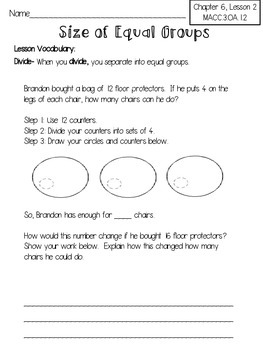Harcourt Go Math Review Worksheets for 3rd Grade-Chapter 6
Wizard Ways in Second Grade
70 Followers
Grade Levels
2nd - 4th
Subjects
Resource Type
Standards
CCSS3.OA.A.2
CCSS3.OA.A.3
CCSS3.OA.B.5
CCSS3.OA.B.6
CCSS3.OA.C.7
Formats Included
- PDF
Pages
20 pages
Wizard Ways in Second Grade
70 Followers
Description
This product was designed to break down the lesson into smaller chunks and as a review for each lesson. Each lesson has two sided worksheet that reviews the lesson and provides practice. I hope this is beneficial to you and your students. This is just for Chapter 6 but the rest of the chapters are coming.
Please leave feedback and don't forget to follow my store to get updates when the other chapters are listed.
Please leave feedback and don't forget to follow my store to get updates when the other chapters are listed.
Total Pages
20 pages
Answer Key
N/A
Teaching Duration
N/A
Report this resource to TPT
Reported resources will be reviewed by our team. Report this resource to let us know if this resource violates TPT’s content guidelines.
Standards
to see state-specific standards (only available in the US).
CCSS3.OA.A.2
Interpret whole-number quotients of whole numbers, e.g., interpret 56 ÷ 8 as the number of objects in each share when 56 objects are partitioned equally into 8 shares, or as a number of shares when 56 objects are partitioned into equal shares of 8 objects each. For example, describe a context in which a number of shares or a number of groups can be expressed as 56 ÷ 8.
CCSS3.OA.A.3
Use multiplication and division within 100 to solve word problems in situations involving equal groups, arrays, and measurement quantities, e.g., by using drawings and equations with a symbol for the unknown number to represent the problem.
CCSS3.OA.B.5
Apply properties of operations as strategies to multiply and divide. Examples: If 6 × 4 = 24 is known, then 4 × 6 = 24 is also known. (Commutative property of multiplication.) 3 × 5 × 2 can be found by 3 × 5 = 15, then 15 × 2 = 30, or by 5 × 2 = 10, then 3 × 10 = 30. (Associative property of multiplication.) Knowing that 8 × 5 = 40 and 8 × 2 = 16, one can find 8 × 7 as 8 × (5 + 2) = (8 × 5) + (8 × 2) = 40 + 16 = 56. (Distributive property.)
CCSS3.OA.B.6
Understand division as an unknown-factor problem. For example, find 32 ÷ 8 by finding the number that makes 32 when multiplied by 8.
CCSS3.OA.C.7
Fluently multiply and divide within 100, using strategies such as the relationship between multiplication and division (e.g., knowing that 8 × 5 = 40, one knows 40 ÷ 5 = 8) or properties of operations. By the end of Grade 3, know from memory all products of two one-digit numbers.





